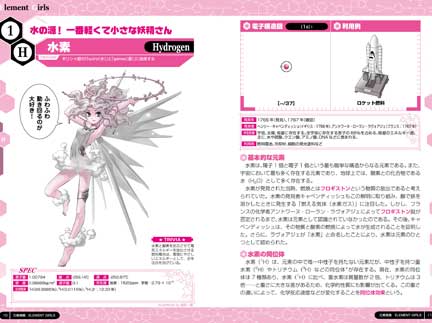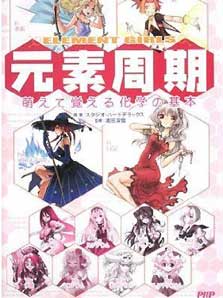Web Japan > Trends in Japan > Pop Culture > "Element Girls" Bring Chemistry to Life
"Element Girls" Bring Chemistry to Life
Book on the Periodic Table Attracts Readers of All Ages
Just about everyone has come across the periodic table of chemical elements in a chemistry or science textbook, but many people find it difficult to remember the names and properties of the different elements. But now the Element Girls, 118 female cartoon characters based on the building blocks of all matter, are gaining fans among a wide range of readers in Japan, including people who do not consider themselves scientifically minded. The Element Girls are the stars of a dictionary of the periodic table published by the PHP Institute, a Japanese firm.
Each Girl in Her Element Everything in the world around us, including our own bodies, is composed of various combinations of the 118 chemical elements. However, studying these elements and learning about their invisible structure of electrons and other particles fails to arouse interest in many people. But an innovative book on the elements titled The Periodic Table: Learning Basic Chemistry Through Moe, released in October 2008, has proven very popular even among those who usually take no interest in chemistry. The explanation for this popularity lies in the fact that each of the 118 elements has been brought to life as a moe character (a cute, adorable female). The lineup of characters includes a nurse, a maid, a fairy, and a queen - figures not usually associated with books on chemistry.

Word play helps readers to remember the names and order of the elements. ©Studio Hard Deluxe & the PHP Institute
Each element was also assigned a catchphrase. For example, the first element in the table, hydrogen, is illustrated with a fairy dancing on a cloud, accompanied by the phrase "Tiny Miss Fairy, the lightest of them all." The slogan for sulfur, the sixteenth element in the table and a component in medicines, gunpowder, and sulfuric acid, is "Chemical, medical, radical girl." Depicted in a gothic black costume, she taunts, "Think you can handle me?" Gold, meanwhile, the seventy-ninth element, is represented by a girl wrapped in a stately gown and bears the slogan, "The element queen: she continues to dazzle throughout the ages."
In addition to the drawings of the characters, the book provides essential data for each element, including atomic weight, melting and boiling points, and isotopes. Interesting facts are also given, such as the origins of the element's name and the person who discovered it. Each element's atomic structure and examples of its use are represented with illustrations, making the book a fun and informative way to acquire a solid understanding of the elements. As of late January 2009, some 24,000 copies of the book had been sold, an exceptionally high number for a book on chemistry.
Manga as a Learning Tool The book's publisher explains that it was looking for a way to create manga that could be used to teach subjects like math, statistics, and biology. It then hit upon the idea of giving the chemical elements personalities reflecting their unique properties as a means of making them accessible to students. The demand for such a learning tool was confirmed when in 2005 the Ministry of Education, Culture, Sports, Science, and Technology quickly ran out of the illustrated periodic tables it had created as part of a plan for promoting understanding of science and technology. Under the editorial supervision of Mitsuda Miyuki, a chemistry lecturer at Musashi Institute of Technology in Tokyo, 33 illustrators worked to humanize each element in the table based on its unique characteristics and qualities.

Hydrogen is depicted as a fairy. ©Studio Hard Deluxe & the PHP Institute
The readership of the book encompasses a wide range of individuals, from schoolchildren to adults in their forties; around two-thirds of the readers are males. The characters are popular among people with an interest in science because they stir the imagination and provide topics for conversation among friends. For science-shy manga and anime fans and schoolchildren soon to encounter the periodic table in their studies, meanwhile, the Element Girls have succeeded in presenting the world of chemistry in a new and inviting way. (March 2009)
- Math the Japanese Way (October 4, 2006)

